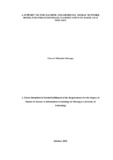A Support Vector Machine and Artificial Neural Network Model for Enhanced Image Classification of Maize Leaf Diseases
Abstract
Image classification accuracy is the total number of images predicted correctly out of the total images in the test dataset in the field of computer vision. Classifying the images accurately is still a challenge due to single image classification models being biased and having high variance. The research created a combination of two models (Artificial Neural Network + Support Vector Machine), the maize leaf disease image features that were extracted were passed to the developed model which classified the diseases with high accuracy compared to the single models. Dimensionality reduction was also considered to reduce the computational complexity and this was achieved by using the Histogram of Oriented Gradient feature descriptor which extracted only relevant features and through away information that was not necessary. The relevant features were considered as the key point since an image was differentiated from each other using the key points. The developed model input was the features extracted which were in a form of a vector space known as an array of numbers and each number represented a particular feature. The developed image classification model consists of two modules; the feature extraction module and the image classification module. The feature extraction module was integrated to work together with the classification module and the features extracted by the feature extraction module were normalized to make them scale-invariant and less susceptible to light which is one of the factors that usually affects image classification accuracy. The classification module was also adjusted by combining two classifiers; Artificial Neural Network and Support Vector Machine and the main reason were for the Support Vector Machine to replace the softmax layer used for classification in the Artificial Neural Network since the Support Vector Machine have the hyperplane component which is a line that accurately separates data belonging to different classes and this made SVM to classify maize leaf disease images accurately. The Support Vector Machine also has the capability of minimizing the generalization error on unseen data which resulted in better prediction results. The common rust, leaf spot, and northern leaf blight and healthy images were used during the feature extraction process, training, and validation of the model. The feature extraction methods were compared on how they perform with image classification models to find out which feature descriptor performs best. The experimental results indicated that the Histogram of Oriented Gradients performs well with the image classifiers compared to KAZE and Oriented FAST and Rotated BRIEF and the Histogram of Oriented Gradients method reduces computational complexity during the image feature generation process. The model which was a combination of three methods, Histogram of Oriented Gradient, Artificial Neural Network, and Support Vector Machine emerged the best in terms of image classification. The experimental outcome based on performance metrics indicated that the developed model had a 0.95 accuracy score. The experimental result shows that the Histogram of the Oriented Gradient together with Artificial Neural Network and Support Vector Machine classifier is the best combination model for maize leaf disease identification since it produced the highest accuracy score compared to the other image classification models. The researcher finally recommends the model to be used today and in the future when it comes to classifying maize leaf disease images.

